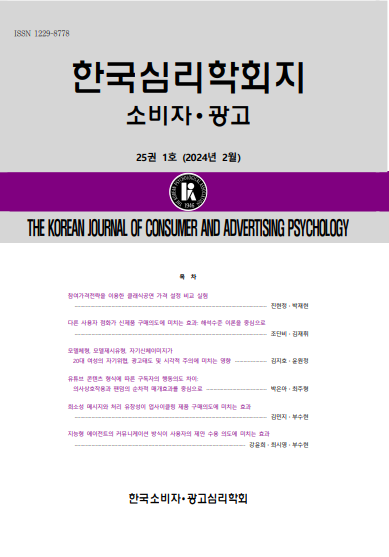open access
메뉴.png)
open access
메뉴 ISSN : 1229-8778
ISSN : 1229-8778
This is an exploratory study aiming to investigate the effect of advertisements in the simultaneous media usage situations, which is highly regarded as a media consumption in multi-media era. Employing experience sample method (ESM), this study examined the characteristics of the exposure to and the attitude toward advertisements in comparison with those in single media usage situations. The results show that the exposure to advertisements happens more frequently in simultaneous media usage situations than in single media usage situations. In addition, there are various types of the exposure to advertisements according to the combination of foreground media and background media in simultaneous media consumption. In simultaneous media usage situations, the duplicated exposure to advertisements has resulted in across foreground media and background media. Media engagement and mood are significantly correlated to the attitude toward advertisements in single media usage situation, while only media engagement correlated significantly with the attitude toward advertisements, but mood, in simultaneous media usage situations.
강미선 (2007). 매체조합(media set)으로 본 다중매체소비행동 연구.『광고연구』, 겨울호, 9-35.
강미선․이수범 (2007). 다중매체 소비행동과 이용자 특성.『광고학연구』, 18(4), 7- 31.
박은아 (2008). 다매체 이용자들의 미디어 동시사용 행태: DMB 초기수용자를 중심으로.『한국방송학보』, 22(1), 44~85.
심미선․강미선․이수범 (2006).『미디어 동시소비 추세(Simultaneous Media Consumption)에 따른 방송광고의 효과강화에 관한 연구』. 한국방송광고공사 연구보고서.
양병화 (2007). 프로그램 무드가 광고태도와 기억에 미치는 영향: 감정모호성의 중재효과와 각성의 매개효과를 중심으로. 『광고학연구』, 18(2), 207-232.
양윤직 (2007). 인게이지먼트. 소비자 관심의 정성적 측정.『광고정보』, 12, 99-103.
이귀옥․최명일 (2009). 경험표집법(ESM)을 통한 동시 매체 이용에 관한 실증적 연구. 『한국언론학보』, 53(4), 138-161.
이종선․장준천 (2009). TV프로그램의 인게이지먼트가 광고 효과에 미치는 영향.『광고연구』, 여름호, 155-190.
조성겸․남인용 (2005). ESM: 디지털 시대 개인 중심의 새로운 조사방법.『마케팅관리연구』. 10(3), 131~141.
최명일․김재범 (2006). 스포츠 팬십이 광고 스폰서 상기에 미치는 영향: 프로그램 시청 기분의 매개효과를 중심으로.『미디어경제와 문화』, 4(4), 7-31.
Aylesworth, A. B., & MacKenzie, S. B. (1998). Context in key: The effect of program-induced mood on thought about the Ad. Journal of Advertising, 27(2), 17-31.
Batra, R., & Stayman, D. M. (1990). The role of mood in advertising effectiveness. Journal of Consumer Research, 17, 203-214.
Batra, R., & Stepens, D. (1994). Attitudinal effect of Ad-evoked moods and emotions: The moderating role of motivation. Psychology & Marketing, 11(3), 199-215.
BIGresearch: The Consumers' Control of Media Continues to Grow, Available: http://www. bigresearch.com/news/big011807.htm
Bourne, L., Dominowski, R., & Loftus, E. (1979). Cognitive processes. Englewood Cliffs, NJ: Prentice-Hall.
Bower, G. H. (1981). Mood and memory. American Psychologist, 36, 129-148.
Bronner, F. E., Bronner, J. R., & Faasse, J. (2007). In the mood for advertising. International Journal of Advertising, 26(3), 333- 355.
Calder, B., & Malthouse, E.(2005). Experiential engagement with online content websites and the impact of cross-media usage. Worldwide Readership Research Symposium, Prague; October.
Consolvo, S., & Miriam, W. (2002). Experience sampling method: Preliminary findings. Paper presented at the User-centered evaluations of ubicomp workshop 4th int'l conference on ubiquitos computing.
Csikszentmihalyi, M., & Csikszentmihalyi, I. S. (1988). Optimal experience: Studies of flow in consciousness. New York: Cambridge University Press.
Csikszentmihalyi, M., & Larson, R. (1984). Being adolescent: Conflict and Growth in the teenage years. New York: Basic Books.
Daugherty, T., Gangadharbatla, H., & Kim, K. (2005). Polychronic media consumption: Exploring attitudes toward simultaneous media usage. Paper presented at the Proceedings of the 2005 conference of the American Academy of Advertising
Gardner, M. P. (1985). Mood states and consumer behavior: A critical review. Journal of Consumer Research, 12(3), 281~300.
Goldberg, M. E., & Gorn, G. J. (1987). Happy and sad TV programs: How they affect reactions to commercials. Journal of Consumer Research, 14(3), 387-403.
Kilger, M., & Romer, E. (2007). Do measures of media engagement correlate with product purchase likelihood. Journal of Advertising Research, 47(3), 313-325.
Malthouse, E. C., Calder, B. J., & Tamhane, A. (2007). The effects of media context experiences on advertising effectiveness. Journal of Advertising 36(3), 7-18.
Martin, B. A. S. (2003). The influence of gender on mood effects in advertising. Psychology & Marketing, 20(3), 249-273.
Mehrabian, A., & Russell, J. A. (1974). An approach to environmental psychology. Cambridge, MA: MIT Press.
Moorman, M. (2003). Context considered: The relationship between media environments and advertising effects. Amsterdam: ASCoR.
Mowen, J., C. (1990). Consumer Behavior. New York: Macmillan Publishers.
Newell, S. J., Henderson, K. V., & Wu, B. T. (2001). The effects of pleasure and arousal on recall of advertisements during the super bowl. Psychology & Marketing, 18(11), 1135-1153.
Pilotta, J. J., Schultz, D. E., & Drenik. G. (2004). Simultaneous media usage: A Critical consumer orientation to media planning. Journal of Consumer Behavior, 3(3), 285~292.
Shultz, D. E. (2006). Media synergy: The next frontier in a multimedia marketplace. Journal of Direct, Data and Digital Marketing Practice, 8(1), 13~29.
Wang, A. (2006). Advertising engagement: A driver message involvement on message effects. Journal of Advertising Research, 46(4), 355-368.
Wang, A. (2007). Branding over mobile and internet advertising: The cross-media effect. International Journal of Mobile Marketing, 2(1), 34-42.
Willson, M. (2008). Media multitasking. Chain Store Age, 71.
Zhang, W., Jeong, S. H., & Fishbein, M. (2006). Competing for attention: How does multitasking influence the recognition of TV sexual context. Paper presented at the International Communiation Association, Dresden, Germany.
Zuzaknek, J. (2002). Experience sampling method: Current and potential research applications. University of Waterloo.